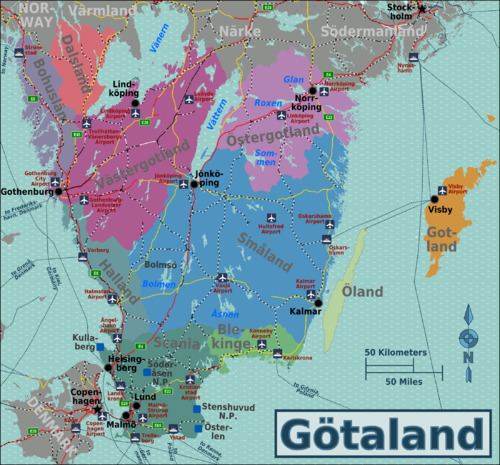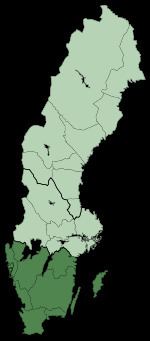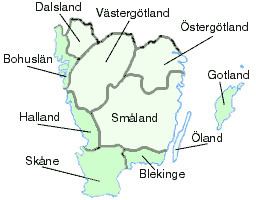Time zone CET (UTC+1) | ||
 | ||
ppna ditt hj rta en resa genom v stra g taland
Götaland ([ˈjøːtaland], also Gothia, Gothland, Gothenland, Gautland or Geatland) is one of three lands of Sweden and comprises ten provinces. Geographically it is located in the south of Sweden, bounded to the north by Svealand, with the deep woods of Tiveden, Tylöskog and Kolmården marking the border.
Contents
- ppna ditt hj rta en resa genom v stra g taland
- Life science in v stra g taland western sweden
- Etymology
- History
- Provinces and counties
- Geography
- References

Götaland once consisted of petty kingdoms, and their inhabitants were called Gautar in Old Norse. It is generally agreed that these were the same as the Geats, the people of the hero Beowulf in England's national epic, Beowulf.

A part of today's Götaland merged with Svealand around year 1100 and thereby formed Sweden; other parts were at that time either Danish or Norwegian. The province of Småland, with the historically important city Kalmar on its coast, was sparsely populated and the status of the Baltic island Gotland varied during the Middle Ages. Bohuslän became Swedish first during the 17th Century after being lost from Norway, around the same time as Denmark lost Scania, Halland and Blekinge to Sweden.

Life science in v stra g taland western sweden
Etymology

The earliest possible mentions of the götar is Ptolemaios (2nd century AD) who mentions the Goutai (Γούται in Greek). Later, Beowulf (8th–11th century) partially takes place among the Géatas. Norwegian and Icelandic sources sometimes use Gautar only for the people of Västergötland, but sometimes as a common ethnic term for the people of both Västergötland and Östergötland. Västergötland appears in medieval Icelandic and Norwegian sources as Gautland (Götland), a form which is not etymologically identical to Götaland.

The name Götaland replaced the old Götland in the 15th century, and it was probably to distinguish the wider region it denoted from the traditional heartland in Västergötland. The name Götaland probably originally referred only to Västergötland and Östergötland, but was later extended to adjoining districts. The name Götaland is probably a plural construction and means the "lands of the Geats", where Göta- is the genitive plural of the ethnonym Göt (Geat). The interpretation that the neuter noun -land is a plural and not a singular noun is indicated by Bo Jonsson (Grip)'s will in 1384, where he stated that he donated property in Swerige (Sweden, i.e. Svealand), Österlandom (Finland) and in Göthalandom to monasteries. Here Götaland appears in the plural form of the dative case.
For the etymology of the element Geat/Gaut/Göt and Goth, see Geat.
History
Götaland came to include the Southern tip of Scandinavia for the first time under King Magnus IV of Sweden in the 14th century, before which the southern tip of Scandinavia had been known as Scandzas or Scania alternatively, according to Tacitus in his work Germanica CE 98. Dense forests between the historic Götaland and Scania had been the traditional dividing line between the two. Scania had its own royal line and it was only under King Strut-Harald that Scania became an integral part of Denmark, around CE 980 cc.
Västergötland and Östergötland, once rival kingdoms themselves, constitute Götaland proper. The Geatish kings, however, belong to the domain of Norse mythology.
Geatland is the land in which the medieval hero of the poem Beowulf is said to have lived.
It was only late in the Middle Ages that Götaland began to be perceived as a part of Sweden. In Old Norse and in Old English sources, Gautland/Geatland is still treated as a separate country from Sweden. In Sögubrot af Nokkrum for instance, Kolmården between Svealand and Östergötland is described as the border between Sweden and Ostrogothia (...Kolmerkr, er skilr Svíþjóð ok Eystra-Gautland...), and in Hervarar saga, King Ingold I rides to Sweden through Östergötland: Ingi konungr fór með hirð sína ok sveit nokkura ok hafði lítinn her. Hann reið austr um Smáland ok í eystra Gautland ok svá í Svíþjóð. In 1384 Bo Jonsson (Grip) stated in his will that the kingdom consisted of Swerige (Sweden, i.e. Svealand), Österland (i.e. Finland) and Göthaland (i.e. Götaland).
The small countries to the south of Finnveden, Kind, Möre, Njudung, Tjust, Tveta, Värend, Ydre were merged into the province of Småland (literally: [the] "small countries"). Off the coast of Småland was the island of Öland, which became a separate province.
Dal to the north west became the province of Dalsland.
Småland, Öland and Dalsland were already seen as lands belonging to Götaland in (Scandinavian) medieval times (12th–15th century).
In the Treaty of Roskilde (1658), the kingdom of Denmark-Norway ceded the Danish povinces of Blekinge, Halland, Scania, and Norwegian province of Bohuslän to Sweden. These provinces are since then counted as parts of Götaland.
The island of Gotland shifted allegiance between the Swedes and the Danes several times. Although the island may be perceived to have closer links to Svealand, it is counted as part of Götaland.
Värmland originally belonged to the Göta Court of Appeal, but the province changed to become part of the Court of Appeal for Svealand for a period of time in the early 19th century.
Provinces and counties
Today, Götaland has no administrative function and is thus an unofficial entity, but it is generally considered to be one of three Swedish lands or parts. It is made up of ten provinces, based loosely on the area originally under the jurisdiction of the Göta Court of Appeals (established in 1634), to which the Scanian lands, Gotland and Bohuslän were added in 1658–79:
Administratively, Sweden is not divided into provinces but into counties (see Län). Although Götaland is defined in terms of the historical provinces and not the counties, it roughly comprises the modern counties of Blekinge, Gotland, Halland, Jönköping, Kalmar, Kronoberg, Östergötland, Skåne and Västra Götaland.
Geography
Deep forests are found in the Småland province, there is plenty of farmland in Skåne, and a little bit of both in Västergötland and Östergötland. Coasts are usually relatively flat and consist of archipelagoes as well as sandy beaches. The two largest islands of Sweden are included in Götaland. The two largest lakes of Sweden are also situated mainly in Götaland. The total area is 87,712 km² with about 4.4 million inhabitants including the second and third largest urban areas of Sweden.
